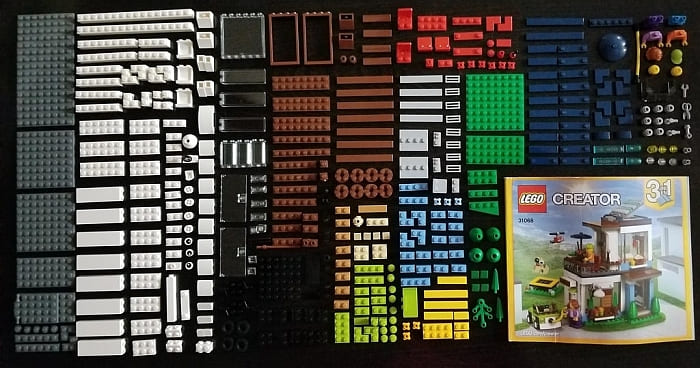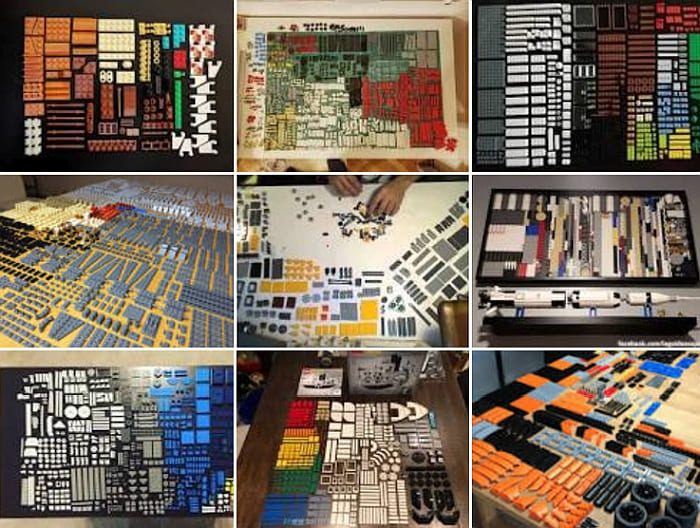If you have been building with LEGO mostly by yourself, you may have not realized that there are many different ways to get ready to build a LEGO set. Older LEGO fans who grew up before parts were sorted into numbered bags may still prefer to dump all the parts together before beginning to build. LEGO introduced numbered bags for larger LEGO sets to break down the building process into smaller sections without the need to open all the bags at once. Whether opening all the bags at once, or only bags for a certain section, many LEGO fans often further organize the parts by type, color, or both, so they can easily find the pieces as they build. This can be especially helpful when working on very large sets (photo below by Crowguys).

And there are also people who take pre-building organization to a whole other level with a process called knolling. According to online dictionaries, “knolling is the process of arranging related objects in parallel or 90-degree angles as a method of organization”. Wikipedia says that the term “knolling” was first used in 1987 by Andrew Kromelow, a janitor at Frank Gehry’s furniture fabrication shop. At the time, Gehry was designing chairs for Knoll, a company famously known for Florence Knoll’s angular furniture. Kromelow would arrange any displaced tools at right angles on all surfaces, and called this routine knolling, in that the tools were arranged in right angles—similar to Knoll furniture. The result was an organized surface that allowed the user to see all objects at once. There is even a book on knolling titled Things organized Neatly: The Art of Arranging the Everyday by Austin Radcliffe.
While I’m sure there are many LEGO fans who have been knolling without ever realizing their method has a name, it was made especially popular in the LEGO fan community by Adam Savage, the American special effects designer, fabricator, actor, educator, television personality, and producer, known as the former co-host of the Discovery Channel television series MythBusters and Unchained Reaction, and for creating models for Star Wars and The Matrix films. His YouTube channel, Adam Savage ‘s Tested, is a wonderful source for entertainment and learning.
Adam is a very experienced and organized tinkerer, neatly aligning all his tools, equipment, and materials. In other words, he is a knoller. In addition, Adam is an enthusiastic LEGO fan, who naturally utilizes knolling when building LEGO sets. There are several videos on Adam’s YouTube channel where you can see him knolling with LEGO before building a set. In the player below, I have included three such examples.
Many other LEGO fans share their knolling layout. To see some great examples, all you have to do is search for “LEGO knolling” on Google.

Most of us organize our building area to some extent before beginning a project. We quickly and efficiently arrange parts into logical groups, but our focus is to begin working on the project as soon as possible. Knolling makes organization a separate project by itself. You slow down and neatly arrange all the parts by type and color before you would begin building anything. Some people take this even further and make knolling a piece of art, separate from the project that they will be building from the parts later. For example, take a look at this beautiful example of knolling by LEGO fan bleatingspectre, who organized all the parts of the #21320 LEGO Ideas Dinosaur Fossils set into an intricate layout.

Organizing, arranging, and laying out LEGO parts before building is not just for efficiency. Many people find the process meditative and therapeutic. And since knolling layouts will be dismantled to build actual sets, they also provide a similar type of “creating and letting go” experience as the sand mandalas made and then destroyed by Buddhist monks.
If you’re intrigued by the process, I would recommend trying it out next time you build a LEGO set. And if you are already an experienced knoller, feel free to share your tips and tricks in the comment section below! Happy knolling!
And you might also like to check out the following related posts:












Wow! I had no idea people do this! The last one is amazing!
I do some minimal organization. Like spreading out the pieces by beg, and putting the smallest parts from the inside bags into cups. I might try knolling on my next build. 😀
I like your idea of putting small parts (like Technic pegs) into little cups! I gotta remember to do that next time I build. Thanks!
I guess I have done something similar but not quite. I get small sorting containers and lay them out in that to make the most of my space. You could call it 3-D knolling I suppose.
I put ‘em up my keister
Knolling is especially helpful for large sets, but the think is, you will need a lot of space to lay out all the parts. So I only really do it with small to medium sets. For larger sets, I use small containers or cups to sort the parts from the bags.
Occasionally I will sort somewhat but the time wasted knolling is equal to the time searching a pile. Not worth all that fidgity nerve racking anxiety inducing sorting. Yes I get anxious (medication needed) performing menial tasks such as sorting. As for those who make art with knolling ….Cool but I can only wish for the ability.
These are great examples! I neatly lay out the bags, and only open the ones that are numbered the same. So, I will open all the #1 bags first. I dump each bag into its own pile and dump the very small unnumbered bags into their own separate piles. That’s it. Once I’m done with the first set of bags, I move on to the next one. This way, I don’t make such a big mess even with big sets. So I organize, but I have never done knolling before. It seems you have to have a lot of patience. Which I don’t. I want to build!
Newbies! In the old days, there were no numbered bags, and we dumped everything in a big pile. This is the only way! 😀
I’d like to see you do that with the UCS Millenium Falcon! Whole box at once! LOL. 😉
I’m a a florist by trade and I use plastic floral arrangement trays to sort my bricks and pieces. They are round,, straight sided, 1½” deep and range in sizes 6” up to 15”.
Any craft store has them. They are perfect!
I also at times enjoy the Zen on knolling. It’s very relaxing. Also when I want to savor a particular set I will knoll.
Well, I guess I was knolling and didn’t even know it. I like to set up at the kitchen table and ley out all the parts. I don’t really align then precisely but in small groups of like parts. The last picture looks like a mosaic, or a cityscape, or an archeological dig. I have never tried that before, but now I’m inspired. It’s like getting two builds out of the same set!
I first thought that was an aerial view of a city! Haha! It takes knolling to another level. Really unique. I haven’t done this before, but I might try with a smaller set.
I guess what I do is somewhat different. I’ll take like Lego and basically make a staircase out of them. This is especially helpful with lots of 2×2, 2×4, etc pieces and because they are not completely connected, they are easily pulled apart when I need the Lego.
Hmmm, I’m not sure if this term will catch on in Swedish. I don’t doubt its usefulness, but it’s a little too similar to a common Swedish slang term that it’ll carry unfortunate connotations…
(Then, there’s also the possibility that it’ll be a reason it’d spread even quicker…)
Haha! Now I’m curious what knolling means in Swedish! 😀
I use cupcake and mini-cupcake tins to separate pieces into.
If people are interested I’ve produced two videos on the topic of sorting out and laying out LEGO (‘knolling’) and I always use this technique when purchasing an order of bricks or prior to starting a build. That way I have all the parts laid out and it’s easy to identify the parts, to distinguish between the parts (that may be similar) and to check that I have all the parts as supplied or that I need.
You can see the videos here:
Ten Benefits of knolling your LEGO: https://www.youtube.com/watch?v=kYsgT-HDJ7g&t=1s
Ten Practical Steps for knolling your LEGO: https://www.youtube.com/watch?v=pftkFkl7-Go&t=1s
I hope you find them interesting and/or useful.
Thanks for sharing! Great info! 🙂
This entire thread reminds me a little of the Monty Python spoof TV studio panel discussion “Storage Jars” (cue dramatic documentary theme music with timpani rolls, trumpet fanfares etc)
sorry for typo earlier.